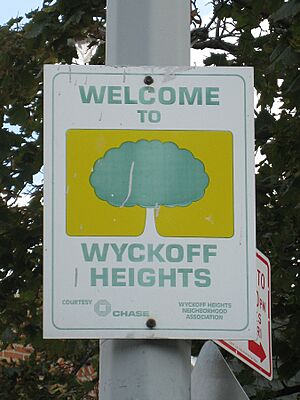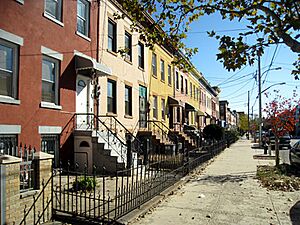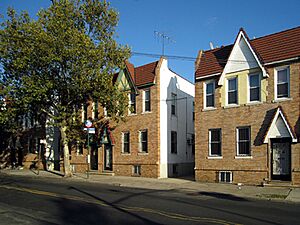Wyckoff Heights, New York City facts for kids
Wyckoff Heights is an area that sits right on the border between two parts of New York City: Brooklyn and Queens. It's like a bridge connecting the neighborhoods of Bushwick, Brooklyn and southwest Ridgewood, Queens.
This area started to become a city neighborhood in the late 1800s. It got its name from the Wyckoff family, who used to own a lot of the land here. Over the years, many different groups of people have called Wyckoff Heights home. First, there were many German immigrants, then Italian families, and more recently, people from Latin American countries and Eastern Europe.
Wyckoff Heights is mostly found in ZIP Codes 11237 and 11385. A couple of important places in the area include the Wyckoff Heights Medical Center and a building that used to be the Wyckoff Heights Presbyterian Church.
Contents
How Wyckoff Heights Grew
Wyckoff Heights began to grow into a city area in the late 1800s. It was named after the Wyckoff family, who owned and farmed most of the land. As parts of the Wyckoff family's farm were sold, new buildings started to appear. This growth spread from Brooklyn into Queens.
In 1890, newspapers announced a new park would be built in Wyckoff Heights. This park is now known as Maria Hernandez Park. In 1892, people who owned property in the Queens part of Wyckoff Heights created a group. This group, called the Wyckoff Heights Improvement Association, worked to get water, sewer, and gas services for the neighborhood. The next year, a company was formed to bring drinking water to the area.
By 1901, people living in the Queens section asked the city government for house numbers and street signs. This was so the post office could start delivering mail to their homes. The last large piece of farmland, about 18 acres, was built on in the 1940s.
Understanding ZIP Codes
At first, mail for the Queens part of Wyckoff Heights was delivered by the Brooklyn Post Office. The Wyckoff Heights Post Office opened in 1951. It served parts of north Bushwick and the Brooklyn side of Wyckoff Heights.
When ZIP Codes were first given out in 1963, all areas whose mail went through a Brooklyn post office got a "112" prefix. This meant that nearby areas in Queens, like Glendale and Ridgewood, also got a Brooklyn mailing address (11227). Parts of Bushwick and Wyckoff Heights were in ZIP Code 11237.
After a big power outage in New York City in 1977, some news stories showed pictures of problems in Bushwick. This made Bushwick get a bad reputation. Because of this, the communities of Ridgewood and Glendale wanted to have a different ZIP code. They wanted to show they were separate from Bushwick.
After people complained, the head of the Post Office, William Bolger, suggested a change. He said the ZIP codes would change if Representative Geraldine Ferraro could show that 70% of residents wanted it. Her office sent out ballots, and 93% of people who voted wanted the change. So, on January 13, 1980, the Queens side of the area got a new ZIP Code: 11385. The 11237 ZIP code was then used only for Bushwick and Wyckoff Heights, and 11227 was removed.
Types of Buildings
The first homes built in Wyckoff Heights were mostly connected wood frame houses. These were often designed for three or six families.
As the neighborhood grew towards the Queens border, builders started using brick and stone. This was to follow new rules about building and fire safety. Many of these older brick buildings are now part of the Cypress Avenue West Historic District.
In the 1940s, the last big building projects in the area happened. These were mostly connected single-family homes. They were built with alleys and garages in the back, which was good for people who owned cars.
Important Places to See
Wyckoff Heights is home to the Wyckoff Heights Medical Center. You can find it at Wyckoff Avenue and Stockholm Street. It was first called the German Hospital of Brooklyn but changed its name in 1918.
There's also a building that used to be the Wyckoff Heights Presbyterian Church. It's located at Harman Street and St. Nicholas Avenue. This church was started in 1895 and rebuilt after a fire in 1928. Today, it is known as the Ridgewood Pentecostal Church.




